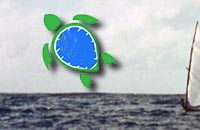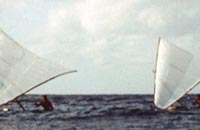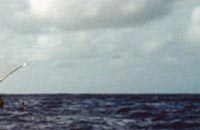|
|
|
|
Part 3: Roughing out the Hull
|
June 05, 2013
One fortunate day in 1992, the universe placed me on the Island of Hawai‘i to visit students at the University of Hawaii campus in Kona. After the class, my students took me down to the Pu‘uhonua o Honaunau, popularly known as the City of Refuge. This cultural site, now managed by the National Park Service, is a great place to see some traditional Hawaiian arts. But that day was especially fortuitous: There was the great Micronesian navigator, Mau Piailug himself, carving a canoe. With him in this picture is Tava Taupu, from the Marquesas Islands. Now you can see that the hull is in the early stages of being carved. Three distinct planes on each side give the canoe hull its general shape, from flatter at the bottom to steep at the sides. In the end, the hull will be more rounded, like the canoe in the background. My own canoe is taking on a shape similar to what’s seen in this picture, but since it’s made out of plywood, it will never quite have that nice rounded look of a finished Hawaiian canoe. In "Harvesting a canoe log…or plywood," I showed sheets of marine plywood all marked out and ready to cut. The long pieces that will be the sides and bottom of the hull are curved, and drawing those curves is tricky. The instructions have you draw lines across the plywood at distinct intervals. Then you mark out points along those lines at specified distances from the edge. To draw the curve, you tack little nails at those spots, then you bend a long strip of wood around the nails, holding it in place with more small nails tacked on the other side of it. Then you draw along the curve formed by that strip. Problem is—as you may recall from using rulers and pencils in school or elsewhere—that the angle at which you hold the pencil makes a difference in where the line goes. Run the pencil up one way, then down the other way, and you often end up with two different lines, because the angle of the pencil was not the same on each run. Worse, the flexible strip of wood actually bent outwards from pushing the pencil along it! This is clearly not a precise science. So after cutting the pieces out with a jigsaw, I paired up the matching pieces, holding them together with clamps (and scraps of wood, as you can see, so as not to leave clamp marks) and sanded their edges until they corresponded exactly. That way at least the hull will be symmetrical, even if not exactly the right shape!
Below you can see the cut-up plywood pieces, laid out in the same arrangement that they were marked on the plywood. You can see how I took the four sets of long pieces and joined them together to make the length of the canoe. I didn’t set them up in order for this picture, but the skinny ones will be the bottom of the canoe, and the wider ones will be the sides. I have glued strips of wood along the tops of the side pieces, and also some shaped pieces with holes for where the outrigger will be attached. More on that later. This is my version of roughing out the hull. Once joined, it will have a shape similar to the canoe pictured with Mau and Tava at the top.
All this was, for me, a few days’ work. Carving a hull from a tree trunk with traditional tools is quite a different story. In my next post, I will talk about those amazing tools of old, for they themselves tell us much about what it took to make a canoe on a Pacific island. —RDK Herman Next: Part 4: Making tools without metal, and, on some islands, without rock |
||
|
||

|
||
Copyright 2016, Pacific Worlds & Associates |








